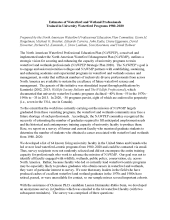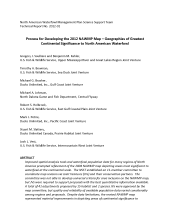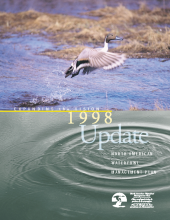2024 NAWMP Update, Español

2024 Actualización del Plan de Manejo de Aves Acuáticas de Norteamérica
Resumen ejecutivo
El Plan de Manejo de Aves Acuáticas de Norteamérica (en adelante, el P M A A N o Plan) nació como respuesta a la disminución de las poblaciones de aves acuáticas y ha servido de base para la conservación continental de las aves acuáticas y sus hábitats
durante casi cuatro décadas en Canadá y Estados Unidos, y durante tres décadas en México. La alianza del P M A A N se ha adaptado y ha tenido un éxito extraordinario en sus esfuerzos. Gran parte del trabajo del P M A A N es llevado a cabo por los Grupos Operativos Regionales (G O R) de Estados Unidos y Canadá. En México también operan dos G O R, pero gran parte del trabajo allí se realiza en Unidades de Manejo para la conservación de la vida silvestre (U M A; ver en el Apéndice A el mapa de G O R y U M A existentes). En México, el gobierno federal es propietario de todos los cuerpos de agua; naturalmente, éstos son fundamentales para alcanzar los objetivos del P M A A N.
La presente Actualización del P M A A N de 2024 revisa los progresos realizados hacia la consecución de las metas establecidas en la Revisión de 2012, detallados en el Suplemento de 2014 (P M A A N 2014) y perfeccionados en la Actualización de 2018. También ofrece recomendaciones para los responsables de la toma de decisiones dentro de la comunidad de manejo de las aves acuáticas referidas a las condiciones cambiantes y las nuevas oportunidades para el éxito de la conservación. El P M A A N tiene una oportunidad sin precedentes de lograr la participación de socios actuales y potenciales e intensificar sus esfuerzos para alcanzar las metas para las poblaciones de aves acuáticas, los hábitats y la gente.
A pesar del éxito del P M A A N y de las cifras de población actuales relativamente elevadas, las pérdidas de hábitat de aves acuáticas continúan a escalas y ritmos que ponen en duda la consecución de la meta del P M A A N de mantener las poblaciones continentales de aves acuáticas. Los paisajes que sustentan a las aves acuáticas no son estáticos; cambian drásticamente a lo largo de los ciclos naturales de humedad y sequía y se ven cada vez más afectados por la actividad humana, como la intensificación de la agricultura, el desarrollo urbano e industrial y el aumento de la demanda de agua. Además, el cambio climático tiene impactos tanto conocidos (por ejemplo, el aumento del nivel del mar) como menos conocidos que pueden exacerbar los desafíos que enfrenta el P M A A N para mantener los hábitats de las aves acuáticas, otras especies de aves y la biodiversidad en general.
La pérdida de humedales sigue siendo una amenaza omnipresente. Un estudio reciente sobre la situación y las tendencias en Estados Unidos informó un aumento del 50% en las pérdidas entre 2009 y 2019 en comparación con los 10 años previos. Durante este periodo se perdieron aproximadamente 270.000 hectáreas de humedales de vegetación palustre, incluidas pérdidas sustanciales de humedales de los baches de las praderas (Lang et al. 2024). En Canadá, muchas jurisdicciones carecen de legislación integral para la protección de los humedales, y es probable que las sentencias judiciales emitidas recientemente en Estados Unidos debiliten las protecciones legales allí existentes. La alianza del P M A A N debe buscar medios innovadores para aumentar el ritmo y la escala de la conservación y restauración de hábitats en todo el continente, y debe hacerlo rápidamente para mantener las poblaciones de aves acuáticas en los niveles deseados.
El lugar donde quizás resulta más apremiante el problema de la pérdida de hábitat es en las Grandes Llanuras del Norte, donde nace anualmente una proporción significativa de las aves acuáticas continentales. En las Grandes Llanuras, la pérdida de pastizales está cerca del 70%, con casi 12 millones de hectáreas perdidas desde 2012, y más de 600.000 hectáreas perdidas solo en 2021 (Fondo Mundial para la Naturaleza 2023). Los Grupos Operativos Regionales del Hábitat de los Baches de las Praderas y de las Praderas estiman pérdidas de pastizales en dichos hábitats a un alarmante ritmo del 0,23% anual. Durante la próxima década, se prevé que los pastizales no perturbados se pierdan a un ritmo entre 7 y 25 veces más rápido que las tasas de protección (Fields y Barnes 2019).
Descargue el documento completo a continuación.




































































